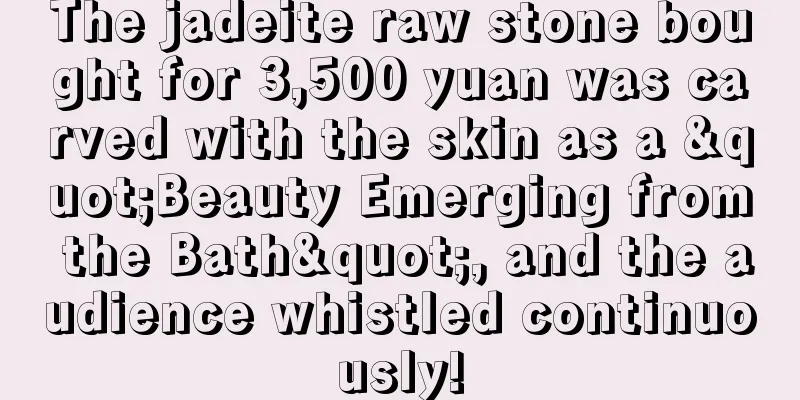Analysis on the market situation of red and yellow jadeite

|
Here I would like to introduce to you the market and identification of red and yellow jadeite. First, let’s talk about the market for red and yellow jadeite. First of all, the price of red is higher than that of yellow. This is the first point. Everyone should know that the price and value of red are second only to green and purple of jadeite. In the middle of the second market, we can see a large number of red jade inlaid products. Let me explain to you about these inlaid products. In fact, many of them are made by merchants specializing in red jade in Jieyang Yangmei Jade City. He will cut the red jadeite very thinly. Although it looks watery, the key is because there is a platinum base underneath to support it. At this time, you can see the reflection from the front and think that the water content is very good, but in fact, this thin red jadeite is not of high value. So what concept is derived from this? If the red jade is thick enough, especially the egg-shaped one, its value is still quite high at this time. It is much more valuable than thinner ones. Regarding red and yellow jadeite, in fact, many enthusiasts and operators have always had a concept, a thing that they cannot understand. What is it? It’s about how to distinguish between natural and roasted ones. First of all, let me tell you that there are many stones of red jade and yellow jade. In fact, after we mine and peel them, the red and yellow colors are not deep enough, or to put it another way, the saturation is not high enough. So what should we do at this time? We can use this optimization technology of heating to make its yellow more yellow and its red more red. So how do you distinguish the burned and unburned red and yellow jadeite? Here are two experiences I would like to share with you. The first is that if it is a fired variety, its red jade and yellow jade must be relatively dry. The natural ones have a certain water head and fineness. The second point is also my personal summary, which is when you look at a raw material or a finished product. If you can find, especially the red color, if you can find a clear dividing line between the flesh and the red skin, we think it is natural red jadeite. Why. Because only natural and slow erosion will cause a clear distinction between the red color and the flesh color inside. If it is artificially heated, then you will see that there is no clear distinction between the red color and the flesh color inside, it is a directly blurred transitional color. This is actually a very important point in identifying whether red jadeite and yellow jadeite are natural. Teacher Zhang, do you have any questions? I would like to ask, are these red and yellow jadeite that have been heated considered fake? Are they either A-grade or natural jadeite? There is a concept I want to correct here. I talked about heat treatment at the beginning. In gemology, this kind of heat treatment is a means of optimization, so it is actually still a natural jade. However, the value of burned and unburned items is actually affected, sometimes the difference is one, two or even more times.
fcgc33 fcpf18 |
<<: If you want to understand these points, the collection value of jadeite will be
>>: Future trends in the jade industry
Recommend
Do you know the meaning of wearing a jadeite Pixiu?
Pixiu is a legendary mythical beast in Chinese hi...
Characteristics of Jade Carving Technology
Friends around me often comment on jade carvings ...
Jade Appreciation | Jadeite bracelets from the Taipei National Palace Museum, each one is stunning
Ji Yun once wrote in his Notes from the Yuewei Th...
A must-have for goddesses!
Warm and elegant amethyst, purple jade is a jewel...
The handed-down "old jadeite" worth nearly a million is actually a B-grade product! Remember these identification techniques
Everyone should know that jade has been introduce...
Huang Fei, the special yellow in my heart
It is inevitable to feel a little tired if you lo...
Several Methods for Identifying Natural Jade
Friends often hold up a piece of jade and ask me ...
A lotus leaf fish is carved from a piece of jadeite full of cracks. The finished product is very pleasing
When many people first start playing with jade, t...
Exquisite jade pendants, the more casual the more extraordinary
Exquisite Jadeite Pendant Seemingly invisible but...
Jade Appreciation | Full of holes and yet breathtakingly beautiful
incomplete, It is a unique aesthetic. It is also ...
Fine jadeite sheets are designed in several classic themes. Which one do you prefer?
Today I will share with you the process of pickin...
When the finest jadeite meets exquisite carving, every piece of work is mouth-watering.
We often see exquisite jade carvings, but we have...
Is jade valuable because of its green color?
Jade is most valuable when it is green. A one-poi...
Tips for women of different ages to choose jade jewelry
Jade is a jewelry that almost every girl will lov...
Thousand-year-old jade, ten-thousand-year-old culture
A good piece of jade requires the blessing of hea...









